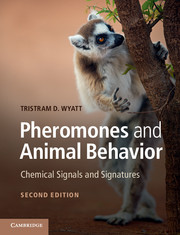Book contents
- Frontmatter
- Dedication
- Contents
- Preface to the second edition
- Acknowledgments
- List of SI prefixes
- List of Abbreviations
- 1 Animals in a chemical world
- 2 Methods for identifying and studying semiochemicals
- 3 Pheromones, chemical cues, and sexual selection
- 4 Coming together and keeping apart: aggregation pheromones and host-marking pheromones
- 5 Territorial behavior and semiochemicals
- 6 Semiochemicals and social organization
- 7 Pheromones and recruitment communication
- 8 Fight or flight: alarm pheromones and cues
- 9 Perception and response to chemical communication: from chemosensory receptors to brains, behavior, and development
- 10 Finding the source: pheromones and orientation behavior
- 11 Breaking the code: illicit signalers and receivers of semiochemicals
- 12 Using semiochemicals: applications of pheromones
- 13 On the scent of human attraction: human pheromones?
- Appendix An introduction to chemical terms for non-chemists
- References
- List of Credits
- Index
3 - Pheromones, chemical cues, and sexual selection
Published online by Cambridge University Press: 05 June 2014
- Frontmatter
- Dedication
- Contents
- Preface to the second edition
- Acknowledgments
- List of SI prefixes
- List of Abbreviations
- 1 Animals in a chemical world
- 2 Methods for identifying and studying semiochemicals
- 3 Pheromones, chemical cues, and sexual selection
- 4 Coming together and keeping apart: aggregation pheromones and host-marking pheromones
- 5 Territorial behavior and semiochemicals
- 6 Semiochemicals and social organization
- 7 Pheromones and recruitment communication
- 8 Fight or flight: alarm pheromones and cues
- 9 Perception and response to chemical communication: from chemosensory receptors to brains, behavior, and development
- 10 Finding the source: pheromones and orientation behavior
- 11 Breaking the code: illicit signalers and receivers of semiochemicals
- 12 Using semiochemicals: applications of pheromones
- 13 On the scent of human attraction: human pheromones?
- Appendix An introduction to chemical terms for non-chemists
- References
- List of Credits
- Index
Summary
For species across the animal kingdom, pheromones and chemical cues play essential roles in successful mate location and mate choice. Given the ubiquity of chemical communication among animals, chemical cues are likely to emerge among the key criteria animals use for mate choice (Johansson & Jones 2007; Smadja & Butlin 2009; Thomas 2011; Wyatt 2010). These include a wide variety of species-specific sex pheromones but also non-pheromone chemical cues such as those associated with genetic compatibility, with the immune system, and with health or disease, which are also important in mate choice.
Darwin proposed sexual selection to explain why the males of so many species have conspicuous bright colors or long tail feathers even though such extravagant features or behavior might reduce survival by natural selection (Darwin 1871). He included chemical signals alongside visual and sound signals as outcomes of sexual selection, describing the distinctive odors of breeding male insects, reptiles, birds, and many mammals. Darwin concluded that the development of elaborate odor glands in male mammals is “intelligible through sexual selection, if the most odoriferous males are the most successful in winning the females, and in leaving offspring to inherit their gradually perfected glands and odors” (Darwin 1871, Vol. 2, p. 281). I have called this “success of the smelliest” (Wyatt 2009).
- Type
- Chapter
- Information
- Pheromones and Animal BehaviorChemical Signals and Signatures, pp. 65 - 104Publisher: Cambridge University PressPrint publication year: 2014
- 1
- Cited by



